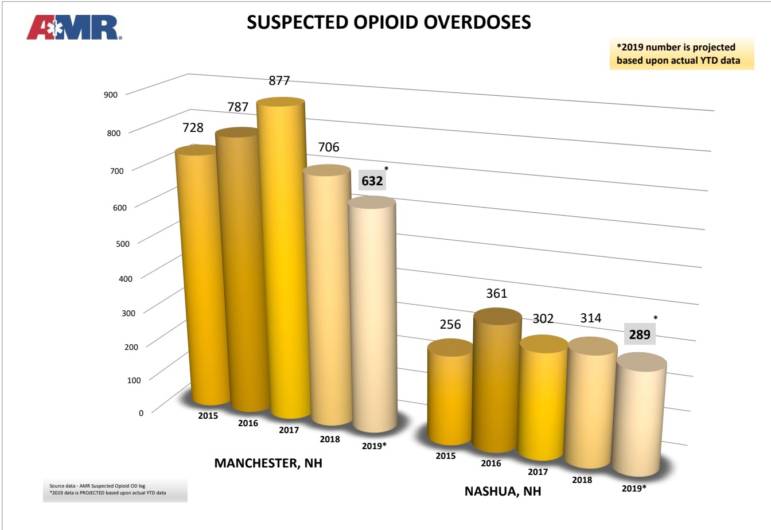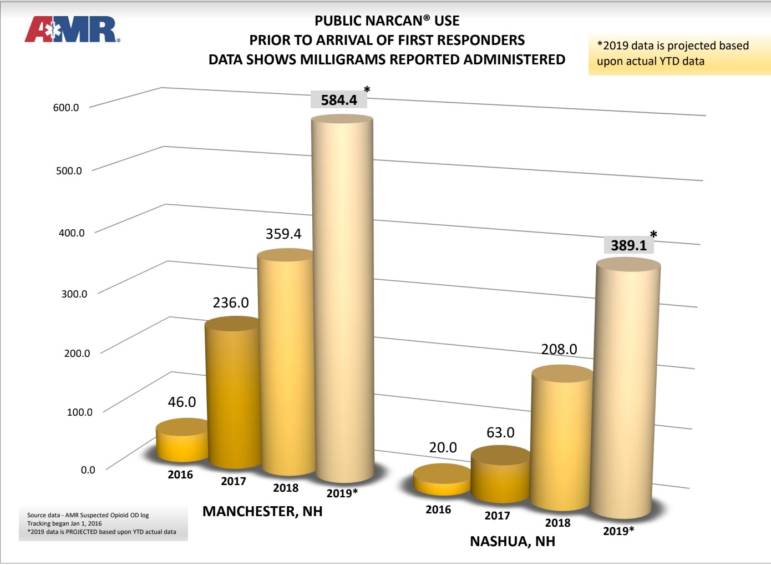
CONCORD, NH — Statistical reports issued this week concerning the opiate epidemic appears to show a decrease in the number of deaths statewide this year but a significant increase in the use by the public of Narcan, a drug used to revive overdose victims, an indication that the drug crisis is far from over.
Kim Fallon, Chief Forensic Investigator in the state Office of the Chief Medical Examiner, said it is too early to tell if this year will end in fewer deaths than last year. Through July 16, 156 people died of drug overdoses across the state but that will likely increase because another 52 cases are “pending toxicology,” according to Fallon. Of those 156 deaths, 132 of them were the result of fentanyl or a combination of fentanyl and other drugs, excluding heroin. Two people died from a combination of heroin and fentanyl; nine others died from other opiates/opioids, and 13 people died from other drugs.
Last year, 471 people died from drug overdoses in the state. In 2011, there were 201 overdose deaths but three years later 332 people succumbed to drugs. By 2017, the number peaked at 488 deaths statewide. Last year, the death toll dropped to 471.
“It does appear to be decreasing but I feel it’s still too early to tell,” Fallon said.
For the city of Manchester, however, overdose deaths are increasing while in Nashua, they are decreasing, according to statistics compiled by Chris Stawasz, regional director of American Medical Response. In Manchester, 32 people have died from drug overdoses through June 30. Nashua recorded 16 deaths in the same time frame.
Still, Nashua’s deaths are down by 23 percent in the last year while Manchester saw a 15 percent increase over those 365 days.

The drug epidemic doesn’t appear to be abating, however, when the use of Narcan is taken into account.
So far this year, prior to emergency personnel responding to 911 calls, residents had already administered 584 (mg) doses.
In Nashua, the public administered 389 (mg) doses prior to first responders arriving.
According to AMR statistics, in 2016 Manchester residents used Narcan 46 times. Through June 30 of this year, it was used 584.4 times, 225 more times than all of 2018.
In Nashua, Narcan was used by the public 20 times in 2016 to revive people from drug overdoses. Through June 30 of this year, Nashua residents used it 389 times, 181 more times than all of last year when it was used 208 times.
Fallon said it will take two to three months to receive toxicology results on those 52 cases “pending toxicology” and for pathologists to review and determine the cause of death.

She explained that “pending toxicology” means the death appeared to be due to a drug overdose based on on-scene investigation and/or autopsy findings but the cause of death is dependent on the results of toxicology testing. Sometimes, she said, test results show that the death was from some other cause and, in cases where deaths were thought to be from some other cause, the tests reveal a drug overdose occurred.
“A death may appear to be the result of a heart attack but it turns out to be cocaine,” Fallon explained.
The 52 cases are a backlog, the result of the time it takes to do the testing and the availability of a pathologist to review the reports. That review depends on the number of scheduled autopsies and the time lost in court appearances.
“We have two doctors and are trying to hire a third,” Fallon said, an attempt to deal with the backlog.







